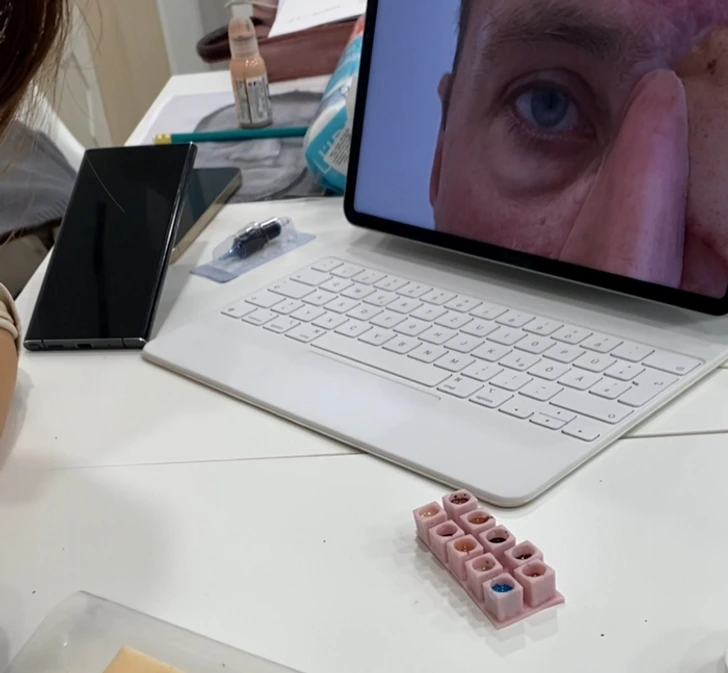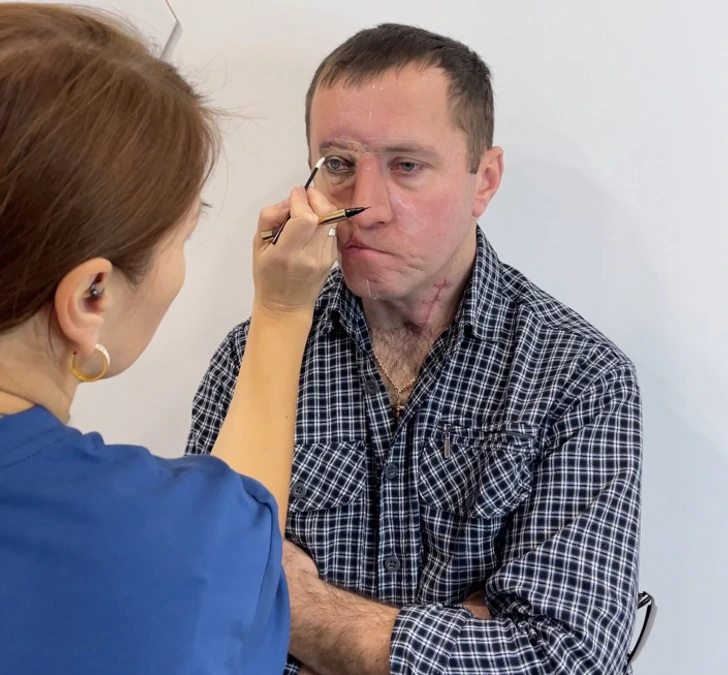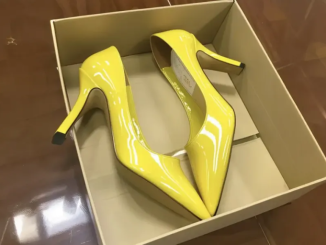For most people, tattoos are a form of self-expression. But for one man, ink became a life-changing solution after a devastating accident left him without an eye. Instead of opting for a traditional glass prosthetic, he took a different path—one that led him to a skilled tattoo artist with the ability to create hyperrealistic tattoos.
A Tragic Accident That Changed Everything

Pavel, a young man with a bright future, suffered a horrific car accident that left him with severe facial injuries. His nose was nearly destroyed, and his right eye was beyond repair. Reconstructing his face would require a series of complex medical procedures, but one of the biggest challenges was how to deal with his missing eye.
Doctors initially explored the possibility of saving what was left of his damaged eye. However, the risk of infection spreading to his healthy eye was too high. The safest option was to remove it entirely.
Pavel accepted the decision with courage, saying:
“I don’t hold on to things that don’t work. It’s better to get rid of something potentially dangerous than to risk losing my other eye too.”
But once the procedure was done, he was left with an important question—how should he replace his missing eye?
From Surgery to Art: A Unique Solution Emerges
Traditionally, people in Pavel’s situation turn to glass prosthetic eyes. But he wanted something different—something that wouldn’t require daily removal or ongoing adjustments.
That’s when doctors introduced him to a highly skilled tattoo artist specializing in hyperrealistic medical tattoos. She had already made a name for herself by helping burn victims, breast cancer survivors, and alopecia patients reclaim their confidence through tattoo artistry.
However, this project was different. She wasn’t just restoring eyebrows or camouflaging scars—she was about to create the illusion of a realistic eye on a flat surface.
This would become one of the most challenging tattoos of her career.
The Artist’s Preparation: A Year of Meticulous Planning
A hyperrealistic tattoo isn’t something that happens overnight. The artist dedicated a full year to studying and preparing for this groundbreaking piece.
Her process included:
- Analyzing old photos of Pavel to match his original eye color and shape.
- Developing a custom pigment palette that could replicate the natural shading of an eye, ensuring the sclera (the white part) didn’t look unnaturally bright.
- Practicing on artificial skin to simulate the texture of scar tissue and skin grafts, testing how ink would blend.
- Consulting with doctors to ensure that tattooing wouldn’t interfere with his healing process.
- Sketching and refining designs over and over again to get the illusion of depth just right.
While the artist prepared, Pavel adjusted to his new face. He remained patient, even joking:
“While you’re practicing, I’ll get used to my new nose!”
Despite the curiosity of strangers, his friends and family stood by him, treating him no differently. Their support gave him the strength to embrace the journey ahead.

The Big Day: Creating a Realistic Eye with Ink
After months of preparation, the day finally arrived. Pavel stepped into the tattoo studio, knowing this was a permanent transformation.
The artist carefully mapped out the placement of the eye tattoo, ensuring that it:
- Aligned naturally with his facial structure.
- Considered the shadows and highlights needed to create depth.
- Worked with the texture of his skin grafts and scars, ensuring the ink settled correctly.
The first outlines were drawn, and within a few hours, the shape of an eye began to emerge. When the artist handed Pavel a mirror, he smiled and said:
“Wow! It actually looks like something!”
There was still work to be done—adding highlights, refining details, and perfecting the illusion—but the transformation had begun.
The Power of Medical Tattoos: A Growing Trend
Pavel’s story isn’t just a remarkable example of tattoo artistry—it’s part of a growing movement where tattoos serve medical and emotional purposes.
Some of the most impactful medical tattoo techniques include:

- Scar camouflage tattoos, which help burn victims and surgery patients feel more comfortable in their skin.
- 3D nipple tattoos, which help breast cancer survivors reclaim their bodies after mastectomies.
- Eyebrow tattoos, providing a solution for alopecia patients and chemotherapy survivors.
- Skin pigmentation correction, helping people with vitiligo and birthmarks achieve a more even skin tone.
The use of hyperrealistic tattoos in medical recovery is revolutionizing self-confidence, showing that tattoos are not just about self-expression—they’re about self-restoration.
More Than Ink: How Tattoos Can Heal Beyond the Surface
Pavel’s journey highlights an important truth—tattoos have the power to change lives.
Beyond their visual appeal, medical tattoos help individuals regain control over their bodies after trauma. Studies show that people who undergo these procedures experience:
- Increased self-esteem
- A renewed sense of identity
- Emotional healing after a traumatic experience
For many, these tattoos shift the focus from loss to empowerment, allowing them to move forward with confidence.

Conclusion: A Story of Strength, Art, and Transformation
Pavel’s story is a testament to resilience, innovation, and the transformative power of art.
With the help of a brilliant tattoo artist, he didn’t just replace his missing eye—he reclaimed his confidence.
His journey serves as a powerful reminder that true beauty isn’t about perfection—it’s about embracing what makes you unique and finding strength in the face of adversity.
In the world of medical tattoos, artists aren’t just creating inked designs—they’re restoring hope, identity, and dignity.
At 58, I rediscovered love, but his ex-wife was determined to destroy our joy

At 58, I thought love had passed me by until I met Oliver. Just as our happiness began to bloom, his ex-wife stormed back into his life, determined to tear us apart. What followed was a battle for peace and the strength to overcome the shadows of the past. Could love conquer all?
“Another quiet morning,” I whispered to myself, gazing out the window at the ocean. The waves rolled in gently, and the breeze carried that familiar, salty scent.
It had been years since my divorce, and I had gotten used to the solitude.
“I don’t need anyone,” I would often remind myself, my fingers tapping rhythmically on the keyboard.
My novels had taken off once I fully committed to writing. The quiet house, with only the sound of seagulls and the ocean, gave me the peace I thought I needed.
But every so often, I’d find myself staring out at the horizon, thinking.
Is this really enough?
It wasn’t until Oliver showed up that I realized the answer might be no.
One morning, as I sipped my coffee on the porch, I noticed him for the first time. A tall, charming man, maybe a few years younger than me, strolling along the beach with his golden retriever. I watched as they passed by my house.
“Morning,” he called out, tipping his head with a friendly smile.
“Good morning,” I replied, feeling a little shy.
Each day after that, I found myself looking out for him. I would watch as he walked along the beach, sometimes playing with his dog, sometimes just staring out at the sea. And each time, my heart would skip a beat.
“Why am I so nervous?” I muttered to myself, shaking my head. “It’s just a neighbor. Calm down.”
But I couldn’t. And my feelings grew stronger every time I saw him. Still, I hesitated.
Can I really open up to someone again?
One afternoon, while I was trimming my roses, I heard a rustling sound and a loud thud behind me.
Startled, I turned to see a golden blur darting into my garden.
“Charlie! Get back here!” I heard Oliver call, and seconds later, he appeared, breathless and apologetic.
“I’m so sorry! He just got away from me.”
I laughed, bending down to pet the dog.
“It’s alright, really. He’s cute.”
“He’s a handful, but I wouldn’t trade him for anything.”
“Do you… enjoy reading?” I asked, my voice tentative, hoping to keep the conversation alive.
Oliver chuckled. “I’m a writer. It kind of comes with the territory.”
“Really?” My eyes lit up. “I’m a novelist too.”
We talked about our favorite books, about writing, and soon enough, the conversation flowed easily.
“You know,” I said, taking a deep breath, “I don’t usually do this, but… would you like to have dinner sometime?”
Oliver raised an eyebrow, surprised but pleased.
“I’d love to.”
Just like that, the plan was set.
The next evening was perfect. We laughed and shared stories. Maybe this is what I’ve been missing all along. But just as I started to relax, a woman appeared at our table. Her eyes were hard, and she looked straight at Oliver.
“We need to talk. Now,” she demanded, completely ignoring me.
“Excuse me, we’re in the middle of…” I started.
“Not now,” she snapped, her eyes never even glancing in my direction. It was as if I didn’t exist.
I felt my face flush, my words stuck in my throat. Oliver looked flustered, shifting uncomfortably in his seat.
“I’m sorry, Haley,” he muttered, standing up awkwardly. “I have to go.”
I watched, speechless, as he followed her out, leaving me sitting there, feeling invisible. The chatter of the restaurant buzzed around me, but I was numb, frozen in place.
The empty chair across from me seemed like a reflection of how abandoned I felt.
Two days had passed since that awkward dinner, and Oliver still hadn’t called. The silence weighed on me more than I wanted to admit. I felt hurt, confused, and, honestly, a little humiliated.
My mind kept replaying the scene, the way he left without a proper explanation, the way that woman had dismissed me as if I didn’t matter.
I sat at my desk, trying to focus on my writing, but it was no use. My thoughts kept drifting back to that night.
Had I made a mistake inviting him? Was he just playing with me? Who was that woman? And why did he leave with her without even a real explanation?
I was about to give up and close my laptop when I heard a knock at the door. My heart raced as I stood up, part of me hoping, and part of me dreading what might come next.
When I opened the door, Oliver was standing on my doorstep with flowers in his hand.
I stared at him, unsure of what to say.
“I’m sorry, Haley,” he began.
“That woman from the other night—she’s my ex-wife, Rebecca. She shows up like that sometimes, trying to stir things up and ruin my relationships. I didn’t want to make a scene in front of you, so I had to leave with her.”
I tried to mask my emotions. “Why didn’t you tell me that then?”
“I panicked. I should have explained. I’m sorry.”
He paused, offering the flowers.
“I want to make it up to you. I have a literary event coming up. Will you come? It’ll be quieter, and maybe we can spend some time together.”
I hesitated a bit but then nodded.I had dressed carefully, hoping for a peaceful evening, a chance to talk to Oliver without interruptions. Maybe, tonight will be different.
Oliver greeted me with a warm smile. “I’m glad you came.”
I smiled back, trying to push aside the unease I still felt.
The evening started well. Oliver’s presentation was engaging. For a while, I forgot about everything that had happened.
But just as I began to feel at ease, the mood in the room shifted.
I saw the same woman from that night at the restaurant. Rebecca. She strode in with a determined look on her face, her eyes scanning the room until they landed on Oliver. My stomach dropped.
Without hesitation, she marched over to where Oliver and I stood, her voice sharp and loud enough to silence the conversations around us.
“You really thought you could just move on, didn’t you, Oliver?” she spat, glaring at him.
The room grew quiet, and all eyes were on us.
“Rebecca, this isn’t the time or place.”
Oliver took a step toward her, trying to calm her down, but it only made things worse.
“Time or place? How dare you?” she snapped, her voice rising. “You’re a liar and a cheat! You think you can just forget about everything we had? You think you can walk away from me?”
People began to whisper, their curiosity piqued by the unfolding drama.
Rebecca’s eyes turned to me then.
“And you,” she said, her voice dripping with venom, “you’re just another one of his mistakes.”
Before I could even respond, she grabbed a glass of wine from a nearby table and threw it in my face. The cold liquid soaked my hair and dress.
Gasps filled the room. For a second, I just stood there, too humiliated to move. My cheeks burned with embarrassment, and all I wanted to do was disappear.
Security rushed in and quickly escorted Rebecca out, but the damage was already done.
I felt small and exposed. The warmth I had felt earlier was gone, replaced by a crushing sense of shame. I wiped my face and looked at Oliver, who stood there, silent and torn.
“What is going on, Oliver? Why is she doing this? And what aren’t you telling me?”
Oliver sighed, running a hand through his hair.
“I… I haven’t told you everything,” he admitted, his eyes full of regret.
“Rebecca and I have been separated for a while, but during that time, I had an affair. It was a mistake, and I’ve regretted it ever since. Then Rebecca came back into my life and took control. She managed everything. My finances. My schedule. She used my guilt to keep me trapped.”
I felt a heavy weight settle over me and realized how deep that mess went.
“I’ve been trying to leave her for good, but she refuses to let go,” he continued. “I didn’t want to drag you into all of this.”
“I don’t think I can do this, Oliver,” I whispered. “I’m not ready for this kind of drama in my life.”
Without waiting for his response, I turned and walked out, the cool evening air hitting my face as I stepped outside.Several days had passed since the disastrous evening at the literary event, and I couldn’t stop thinking about Oliver. Despite everything that had happened, I missed him.
I tried to push the feelings away, to convince myself that walking out had been the right choice, but the ache of missing him wouldn’t fade.
One afternoon, as I sat by the window, a flicker of movement caught my eye. It was at Oliver’s house. I watched as Rebecca hurried back and forth, swiftly loading boxes into a car.
Is he moving out? Why is she here?
I couldn’t ignore it any longer. I had to tell him that he needed to be stronger, to stand up for himself, and to stop letting people like Rebecca control his life.
Summoning my courage, I stepped outside and made my way toward his house.
But as I approached, something felt different. Oliver’s car pulled up, and when he stepped out, there was a calm, resolute look on his face—one I hadn’t seen before. I hesitated, keeping my distance, watching as he walked straight to Rebecca.
“It’s over, Rebecca,” I heard him say. “Take the money, take the house—whatever you want. But you will not interfere in my life anymore.”
Rebecca froze, staring at him in disbelief. “You can’t be serious.”
“I am,” he said, his voice unwavering. “If you don’t respect that, I’ll file a restraining order. This ends today.”
I stood there, shocked. That was a side of Oliver I had never seen.
At that moment, I knew. He had finally taken control of his life, and that was exactly what I needed to see.



Leave a Reply